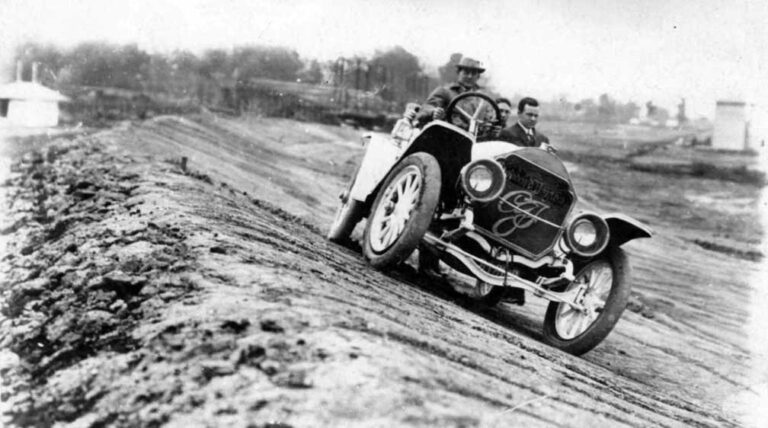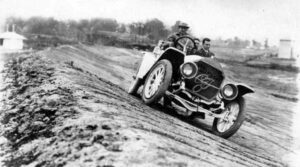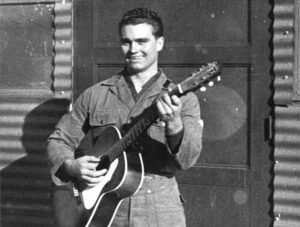Ever heard of Carl G. Fisher? If the answer is “no,” let me ask another question: Have you ever heard of the Indianapolis Motor Speedway or driven along one of the many routes along the U.S. highway system?
Assuming the general response to the second query is “yes,” let me share a little story.
Humble Beginnings
Carl G. Fisher was an unlikely transportation entrepreneur. Born in Greensburg, Indiana, in 1874, Fisher suffered from extreme astigmatism in both eyes. From childhood, his eyesight caused issues ranging from severe headaches to blurred vision.
Needless to say, between the headaches and the poor vision, he had trouble paying attention in school.
At age 12, he dropped out and went to work to help support his family, which had been abandoned by an alcoholic father. Over the next few years, young Fisher worked in grocery markets and bookstores, eventually becoming a salesman of newspapers, books, tobacco and candy on trains headed out of Indianapolis.
In 1891, Fisher and his brothers opened a bicycle repair shop. It was Fisher’s first of many ventures into the transportation business. He soon became involved in bicycle racing, a precursor to an interest in automobile racing, which burgeoned at the turn of the 20th century.
An Innovative Invention
Before the automobile became Fisher’s obsession, however, he and a friend first helped perfect the acetylene headlight — a decade before the electric headlight came along. In fact, Fisher’s business supplied virtually every headlight used in every automobile in the U.S.
When he and his partner sold their headlight company to Union Carbide for $9 million, Fisher suddenly found himself a very wealthy man.
The Birth of ‘The Brickyard’ and the Indy 500
While living in Indianapolis in the early 1900s, Fisher operated what has been referred to as the first automobile dealership in the U.S.
But his interests went far beyond selling motorized vehicles to the public. Carl Fisher loved racing, and he sponsored race cars in addition to racing himself.
It’s only natural that he had a vested interest in developing dedicated racecourses where automobiles could safely race in front of spectators — who could be equally safe while watching the races.
The result was the Indianapolis Motor Speedway, a 2.5-mile-long circuit that Fisher opened in 1909. In short order, the racetrack, then known as “The Brickyard” because of its brick-paved surface back in the day, became the preeminent leader as a testing ground for automobiles and racing.
Surprisingly, the first event at the speedway was not an automobile race: It was a helium-filled balloon competition, another foray Fisher took into the transportation business. In fact, later that year, Fisher and a partner planned a Trans-Atlantic balloon crossing; however, the effort apparently never made it to fruition.
From the Racetrack to the Road
With the success of Indianapolis Motor Speedway, Fisher next set his sights on building roads to handle the growing automobile traffic across the U.S.
In 1912, he proposed a trans-continental highway that would cross the country, beginning at Times Square in New York City and end at San Francisco’s Lincoln Park. Fisher called the transportation corridor the “Lincoln Highway,” named not after its terminus point but rather after Fisher’s favorite president, Abraham Lincoln.
The highway’s original route passed through 13 states — New York, New Jersey, Pennsylvania, Ohio, Indiana, Illinois, Iowa, Nebraska, Colorado, Wyoming, Utah, Nevada and California. Some 700 cities and towns sat along the route, and the economic benefit for each community was impressive.
Originally 3,389 miles long, the Lincoln Highway was well developed in some areas … but it was a muddy quagmire in others. The U.S. Army effectively demonstrated the high and low points of the route in 1919 when it staged an east-west convoy across the country. In fact, Dwight D. Eisenhower, future WWII general and president of the U.S., is thought to have developed his dream of the U.S. interstate system while participating in the convoy.
Even though the Lincoln Highway had its difficulties, for automobiles it was the equivalent of a transcontinental railway — and it improved over the years.
Eventually, a large portion of the highway became U.S. Route 30, from Pennsylvania to Wyoming. The highway was ultimately replaced by Interstate 80, today’s primary northern east-west route across the country.
Moving Freight Across the Country
Throughout its more-than-a century history, the route has been vital to U.S. commerce and has served as a major transportation route for both tourism and trucking across the north-central portion of the U.S.
With the success of the Lincoln Highway under his belt, Carl Fisher decided to build on his efforts.
His next project was the development of a north-south route from Michigan to Miami. Construction on the road began in 1914, and the route — known as the “Dixie Highway” — was completed in short order. Following the Dixie Highway’s completion in 1929, Fisher himself led the first caravan from Florida to Indiana.
The Dixie Highway’s route was not as direct as that of the Lincoln Highway, and it ultimately stretched 5,786 miles, including both an eastern and western route. Today, U.S. Route 1 and Interstates 65 and 75 generally approximate the original corridor of the Dixie Highway.
As Fisher’s highways developed and became even more vital to the nation’s economy, Fisher himself saw potential for development of Miami as a tourist destination. He funded the Collins Bridge connecting Miami and Miami Beach and was a leading promoter of the Florida land boom of the 1920s.
He also saw an equal possibility for a tourism destination at the eastern end of Long Island, New York. Unfortunately, this idea came about in 1929 and was brought to an abrupt halt by the Great Depression. The stock market crash also stopped Fisher in his tracks and led to the loss of his formidable wealth.
A Lasting Legacy
No longer a rich man, Fisher settled in Miami Beach and performed odd jobs for acquaintances to get by.
In 1971, he was inducted into the Automobile Hall of Fame in 1971 — and today, Fisher Island, located south of Miami Beach, is one of the most exclusive residential areas in the country. Tragically, Fisher was destined to follow his father’s footsteps into alcoholism, and he died of a died of a stomach aneurism in 1939.
Today, Carl G. Fisher is best remembered as developer of the Indianapolis Motor Speedway and the “Greatest Spectacle in Racing.”
Far more important, however, is his contribution to the U.S. transportation system and his foresight in developing the precursors to the U.S. interstate system.
Indirectly, Fisher’s vision led to a boon for the commercial trucking business. As the freight industry expanded and spread from coast to coast, trucks laden with cargo traveled across the country — often along the routes paved by Fisher’s early highways.
Since retiring from a career as an outdoor recreation professional from the State of Arkansas, Kris Rutherford has worked as a freelance writer and, with his wife, owns and publishes a small Northeast Texas newspaper, The Roxton Progress. Kris has worked as a ghostwriter and editor and has authored seven books of his own. He became interested in the trucking industry as a child in the 1970s when his family traveled the interstates twice a year between their home in Maine and their native Texas. He has been a classic country music enthusiast since the age of nine when he developed a special interest in trucking songs.








